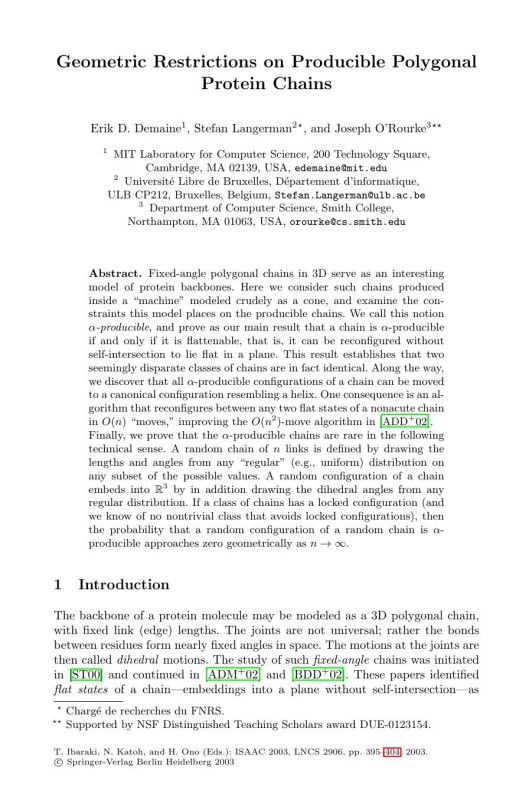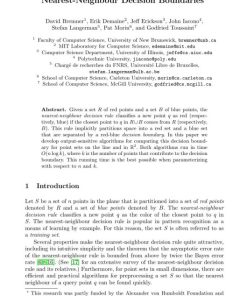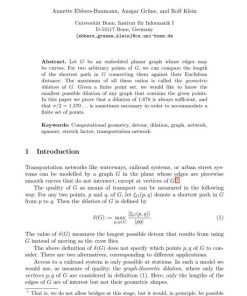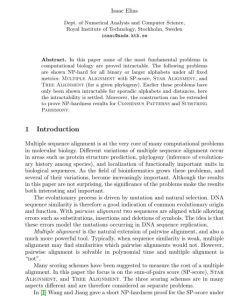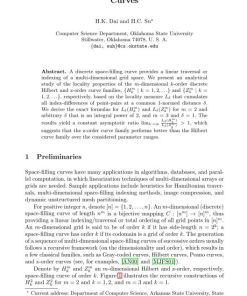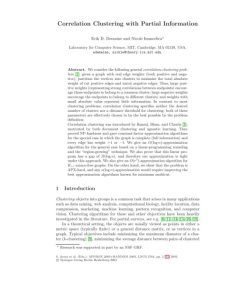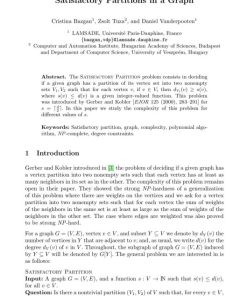Geometric Restrictions on Producible Polygonal Protein Chains 1st edition by Erik Demaine, Stefan Langerman, Joseph O’Rourke ISBN 3540206958 9783540206958
$50.00 Original price was: $50.00.$25.00Current price is: $25.00.
Authors:Erik D. Demaine, Stefan Langerman; Joseph O’Rourke , Tags:Algorithms and Computation , Author sort:Erik D. Demaine, Stefan Langerman & O’Rourke, Joseph , Languages:Languages:eng , Published:Published:Oct 2003
Geometric Restrictions on Producible Polygonal Protein Chains 1st edition by Erik D. Demaine, Stefan Langerman, Joseph O’Rourke – Ebook PDF Instant Download/Delivery. 3540206958, 978-3540206958
Full download Geometric Restrictions on Producible Polygonal Protein Chains 1st Edition after payment
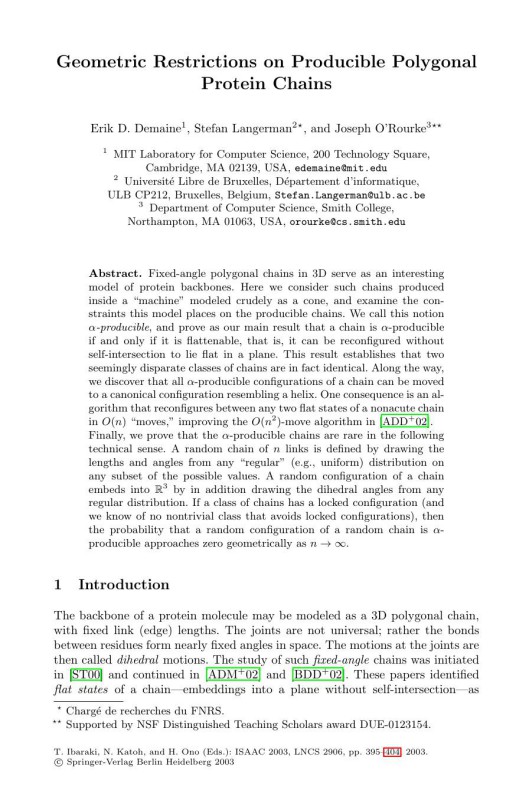
Product details:
ISBN 10: 3540206958
ISBN 13: 978-3540206958
Author: Erik D. Demaine, Stefan Langerman, Joseph O’Rourke
Fixed-angle polygonal chains in three dimensions serve as an interesting model of protein backbones. Here we consider such chains produced inside a “machine” modeled crudely as a cone, and examine the constraints this model places on the producible chains. We call this notion producible, and prove as our main result that a chain whose maximum turn angle is α is producible in a cone of half-angle ≥ α if and only if the chain is flattenable, that is, the chain can be reconfigured without self-intersection to lie flat in a plane. This result establishes that two seemingly disparate classes of chains are in fact identical. Along the way, we discover that all producible configurations of a chain can be moved to a canonical configuration resembling a helix. One consequence is an algorithm that reconfigures between any two flat states of a “nonacute chain” in O(n) “moves,” improving the O(n2)-move algorithm in [ADD+]. Finally, we prove that the producible chains are rare in the following technical sense. A random chain of n links is defined by drawing the lengths and angles from any “regular” (e.g., uniform) distribution on any subset of the possible values. A random configuration of a chain embeds into ℝ3 by in addition drawing the dihedral angles from any regular distribution. If a class of chains has a locked configuration (and no nontrivial class is known to avoid locked configurations), then the probability that a random configuration of a random chain is producible approaches zero geometrically as n → ∞.
Geometric Restrictions on Producible Polygonal Protein Chains 1st Table of contents:
-
Introduction
- 1.1 Background and Motivation
- 1.2 Protein Chains and Their Importance in Biological Systems
- 1.3 Geometric Constraints in Protein Chain Folding
- 1.4 Objectives of the Paper
- 1.5 Structure of the Paper
-
Fundamentals of Protein Structure
- 2.1 Basic Building Blocks of Proteins: Amino Acids and Peptides
- 2.2 Overview of Protein Folding
- 2.3 Definition of Protein Chains and Polygonal Structures
- 2.4 Importance of Geometric Constraints in Protein Folding
- 2.5 Existing Models for Protein Chain Conformations
-
Geometric Framework for Protein Chains
- 3.1 Geometric Representation of Protein Chains
- 3.2 Bond Angles and Dihedral Angles in Protein Chains
- 3.3 Restrictions Imposed by Geometrical Properties (e.g., Bond Length, Angle Constraints)
- 3.4 Defining Polygonal Shapes in Protein Chains
- 3.5 Mathematical Models of Protein Chains and Geometric Restrictions
-
Polygonal Protein Chains: Feasibility and Existence
- 4.1 Characterization of Polygonal Shapes in Protein Structures
- 4.2 Conditions for the Existence of Polygonal Protein Chains
- 4.3 The Role of Topological Constraints in Polygonal Protein Chains
- 4.4 Geometrical Proofs for the Existence of Polygonal Structures
- 4.5 Examples of Polygonal Chains in Biological Systems
-
Geometric Restrictions on Protein Chain Folding
- 5.1 Spatial Constraints and Folding Pathways
- 5.2 Effects of Bond Angles on Protein Chain Conformation
- 5.3 Geometric Restrictions and Folding Energy Landscapes
- 5.4 Kinetic vs. Thermodynamic Folding in the Context of Geometrical Constraints
- 5.5 Analysis of Folding Algorithms Considering Geometric Restrictions
-
Applications and Implications of Geometric Constraints
- 6.1 Design of Synthetic Protein Chains with Polygonal Structures
- 6.2 Implications for Protein Engineering and Drug Design
- 6.3 Constraints on Protein Interactions and Binding Sites
- 6.4 Understanding Protein Misfolding and Diseases (e.g., Alzheimer’s, Parkinson’s)
- 6.5 Case Studies of Polygonal Protein Chains in Nature
-
Mathematical and Computational Approaches
- 7.1 Computational Geometry for Protein Folding
- 7.2 Algorithms for Determining Feasible Polygonal Chains
- 7.3 Simulation and Visualization Techniques for Protein Chain Folding
- 7.4 Computational Models for Geometric Constraints in Protein Chains
- 7.5 Optimization Methods for Predicting Polygonal Protein Structures
-
Challenges and Open Problems
- 8.1 Limitations of Current Geometric Models
- 8.2 Handling Complex Topologies and Larger Protein Chains
- 8.3 Incorporating Flexibility and Dynamic Folding
- 8.4 Geometric Constraints in Multi-Chain and Multi-Subunit Proteins
- 8.5 Open Questions in the Study of Geometric Restrictions in Protein Folding
-
Future Directions
- 9.1 Advancements in Geometric Modeling for Protein Folding
- 9.2 Machine Learning Approaches for Protein Structure Prediction with Geometric Constraints
- 9.3 Hybrid Models for Geometric and Thermodynamic Aspects of Folding
- 9.4 Applications to Personalized Medicine and Biotechnology
- 9.5 Integrating Geometric Constraints with Experimental Data
-
Conclusion
- 10.1 Summary of Key Findings
- 10.2 Implications for the Understanding of Protein Folding
- 10.3 Potential Applications in Synthetic Biology and Biomedical Engineering
- 10.4 Future Outlook and Research Directions
People also search for Geometric Restrictions on Producible Polygonal Protein Chains 1st :
geometric distribution rules
geometric constraints are available in which environment
what are the conditions for a geometric setting
3 restrictions of common ratio in geometric series
difference between geometric and dimensional constraints

